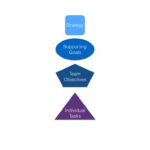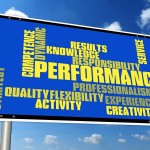by Brian Clark | learning management systems, LMS, on-boarding, Productivity, succession planning, talent retention
 A step by step guide to choosing the best LMS for your needs
A step by step guide to choosing the best LMS for your needs
How many times have you walked into a store with something specific in mind only to get home and realize that you blew your budget and now are the proud owner of 10 items that you didnt need? Over the years, various LMS systems have tried to be all things to all people; the more bells and whistles the better. With all these added features, choosing your LMS can be overwhelming and confusing which can lead to the above example.
According to a survey conducted by The eLearning Guild, nearly one-third of respondents said they were not satisfied with the LMS product they were using. There could be a variety of reasons for this but one thing is for certain, in order for a successful outcome to happen, a company must know what is most important to them and make sure the LMS performs those requirements well.
This short guide will help clarify how to choose the best learning management system software and avoid the exhaustive and costly mistake of selecting an LMS that is poorly matched to your company needs.
The Wrong LMS Wastes Time and Money
The investment of time and money that organizations make in learning management systems is significant and lets face it, nobody likes to lose time or money.
With over 600+ LMSs on the market, it can be quite daunting to choose the right LMS let alone face the consequences that can set you back months or even years in missed learning opportunities.
Having a well thought out plan ahead of time when considering an LMS is a sure way to avoid buyers remorse. It also is a great way to position yourself for optimal success when choosing a learning management system software.
Choosing the Right LMS
In 2004, American psychologist Barry Schwartz published a book called The Paradox of Choice Why More is Less. It argued that by eliminating the amount of consumer choices will greatly reduce anxiety for shoppers. The following guidelines will set a path for success by eliminating the LMS playing field from 600 to 1. The LMS that best fits your needs and goals.
Preparation
One of the most important parts of the entire LMS selection process is in preparation. This is the time to really focus on the details.
- Choosing an LMS is not a one person job. Its important to create a team made up of a variety of departments in your company. These folks will be using the LMS in different ways and their feedback is critical. The features an information technology person deem important may be quite different then the HR perspective, right?
- Do you have a leader? This person needs to drive the team, an LMS champion. They should be well versed in your company s learning needs, has the backing of management and controls the budget. They should also be able to bridge the various needs of the LMS team and come to a consensus.
- Who will be using the LMS? Its important to define your customers and the ways in which theyll be utilizing the LMS. Come up with a variety of scenarios or initiatives with the customers in mind. Map out exactly what needs to be done and what tools are needed to implement the initiative. One example would be onboarding. If you know that in the next year that your company will be hiring a lot more staff and/or expect changes in user information, it will be particularly useful to have real-time integration features with your selected LMS.
- Make a priority list. Your team of decision makers will be a big help in narrowing down the list. Think about what your company goals are as well as some big projects coming up. Tough decisions will need to be made as needs will not be the same across the organization.
Requirements
Once a priority list has been drafted, it should be fairly easy to translate that into requirements. One of the biggest traps when shopping for an LMS is asking for every feature that is available that may or may not be needed. Follow your list of priorities to stay focused and on task. An easy way to do this is with the 80/20 rule take care of 80 percent of your needs then see how successfully you can fulfill the rest of the 20 percent. Make everything not on your list of priorities to nice to have. Visit our partners, – leaders in fashionable footwear!
Vet available Learning Management Systems
At this point, you have slowly narrowed your priority list down to only the most important features along with some nice to haves. Now, the next step is to narrow your choices of LMS providers. Your list of top 10 requirements will rule out non qualifying products. For instance, if you would like an LMS that will leverage your investment in SharePoint, then this would be a good vetting criterion. There are many different pricing ranges for products. Ballpark licensing costs are another good vetting criteria.
Product Evaluation
- Request for information. An RFI contains a list of all your requirements with a few questions per requirement for vendors to answer. Evaluate the vendor responses with a scorecard that allows scorers to rate how well the vendor meets each requirement on a 5-point scale. After scoring the responses to the RFI, you can rule out some of the lower-scoring vendors and continue evaluating the top contenders.
- In use demonstrations. Invite each of the top contenders to visit your organization for a half day to demonstrate their product. A good approach is to give them all the same use case ahead of time so you can compare them equally. Again, you can use a scorecard to evaluate the vendor demonstration and rule out those vendors whose products did not perform well.
- Trial version. As you continue to evaluate the finalists, you may ask for a trial version of the LMS software where you can explore the finalist products. Hands-on exploration will give you a better sense of the user-interface design, features and capabilities of the product.
LMS Selection 
The final step is to select an LMS. Send a Request for Proposal (RFP) to each of your finalists asking for pricing quotes, implementation timeframes and support options. If you followed the above guidelines, you should feel very confident in your choice of learning management system software.
Leverage the Benefits of Your LMS
You should take the opportunity during your LMS implementation project to review your current business workflows and amend them as desired. You want to gain productivity and automation with your LMS and not be messing around with your LMS to get it do the things you need. There are so many benefits you will gain with an LMS, among these are:
- More engaged workforce with self serve learning and development.
- Reduced training costs.
- Track and report easily to manage compliance and regulatory requirements.
- Engage with new hires and offer consistent high quality on-boarding.
- Use the LMS for resource planning, succession planning and skills gap analysis.
In today s business environment, an LMS is the backbone for training and development and continues to gain in popularity. One of the biggest advantages of an LMS is efficiency. In fact, many companies report a 50-70% cost savings just by switching from instructor-based training to eLearning. Your LMS should be able to manage online, instructor led and blended learning delivery to gain efficiencies in all learning modalities.
by Brian Clark | change, culture, development, Employee Engagement, Performance
According to a recent study published by SHRM, 9 out of 10 line managers report that they do not like preparing for and delivering the annual performance review. 9 out 10 HR Managers report that they cannot rely on the data in the annual performance reviews. And most employees will agree that they would rather go to the dentist than go through a performance review!
What’s the point? Many people complain they see no outcomes from performance reviews. If there are no next actions then why are they conducted in the first place?
Clearly the system is broken! 
It does not have to be this way. Give your managers the learning they need to deliver effective performance reviews that will build a performance culture and improve employee engagement. Performance Reviews can be a positive experience for both managers and their people.
Introducing the Performance Management and Development Toolkit for Managers. This set of e-learning courseware will solve some of the most common performance management, performance review and development headaches. Turn the one time per year discussions into on-going discussions. Create valuable annual reviews driving development resulting in more motivated employees.
Get in touch and we can let you have a look at this suite of e-learning modules.
by Brian Clark | Business Process, capability, change, Employee Engagement, Performance, Productivity
Productivity is a hugely popular topic and there is no shortage of authors, teachers and ‘gurus’ out there to help you get more productive. You may be using Microsoft Outlook at work but if you do a search on ‘productivity apps’ you will get an avalanche of options for your laptop, phone and tablet. Productivity is a big deal and big business. It has advanced way beyond the days of sending people to a time management program and see them return with a paper planner in a binder. If you don’t remember those days you did not miss much.
Do you ever wonder why key strategic milestones and projects are not completed successfully and on time? Is your organisation slow to respond to changing internal external pressures? Are you only discovering failed or stalled projects when it is too late?
Organisational and team productivity is not always a sum of the ‘parts.’ Every person in a team may be highly productive but this does not always translate to overall productivity when measured by successfully achieving objectives. As a leader you need to take a deeper dive and build processes that will ensure productive activity achieves outcomes. 
Our process on a high level includes the following and we may go into a deeper dive in subsequent posts. In addition we have a number of tools to help teams and managers execute tasks and achieves tasks more effectively.
- Your corporate or organisation’s strategy must be clearly ‘cascaded’ to the individual level. Each person must have ‘line of sight’ from their role to the overall strategy.
- Your strategy should be broken down into goals, objectives and tasks in alignment with your structure and the strategic horizons assigned to roles and job titles in your business. This is a very simple structure.
- The most difficult phase of achieving excellence in execution is changing the way people work together and introducing systems and discipline in at least one management process. This process includes the following steps:
- Weekly team meetings with a structure set of questions coupled with accurate note taking, task creation, task assignments and follow up. The manager meets with the team every week.
- The agenda is fast and focused.
- What are you working? Is it on your work plan and/or task list?
- Is there anything or person disrupting or distracting you from achieving completion?
- The manager asks, “What can I do to ‘clear the path’ or support you in achieving your tasks?” This is recorded as well.
- The manager has one day or less to follow up with the person on actions taken.
4. The meetings are fully documented and retained. I have clients who use OneNote or Evernote to record these meetings. The information captured is excellent for use in management meetings, reporting up the organisation and for performance reviews with the manager and team members. This post is sponsored by our partners.
This can be a major change program depending upon existing systems and processes in your business and the culture you have. This type of process must be implemented at all levels of the organisation and not focused on one business unit or functional area. All managers who will be conducting the weekly team meetings must be trained in how to conduct them and record information. If a manager is away for any reason the weekly meetings must still occur.
The end in mind for this change initiative is achieving higher levels of engagement, adaptability and competitiveness. You achieve these outcomes by enabling people to work effectively to achieve your strategic objectives.
by Brian Clark | 70:20:10, LMS, sales training
How to boost your company’s sales using effective blended learning.
Your LMS can make a huge impact on the sales performance of your organisation by supporting effective blended learning. It is often overlooked as a key component of sales and marketing technology, and yet a learning management system will contribute to deliver measurable sales growth if used effectively for both internal and external audiences. I am going to cover some ideas on how to use your LMS for your internal audiences that will form a key part of your sales strategy to deliver sustained predictable revenue growth for your business. We are talking here about people with job titles like those below who are responsible for delivering sales results.
• VP of Sales
• Sales Managers
• Sales Executives
 • Sales Representatives
• Sales Representatives
• Internal Sales
• Marketing Managers and their teams
The most basic use of the LMS is to capture and maintain training histories. This should be no different for your sales team. By maintaining sales training histories you will be able to more effectively measure the return on investment of the training you are investing in. If you are a Sales Manager you should be very interested in this data when you are preparing to request money to undertake further training. If you are a Learning and Development Professional, you may include this data in your reporting to highlight areas of improvement and to verify a link between training investment and improved performance on the job.
• Sales training is often instructor led and the learners are then expected to apply their learning to their jobs. In ideal cases, there is follow up and practical coaching to ensure there is learning retention. If you outsource your sales training, consider these ways to use your LMS to get better results:
• Create competency frameworks for your training that can be aligned with different roles and job titles.
• Ask your training provider for resources that can be adde to the LMS for learners to refer to after the training as refreshers.
• Set up discussion forums to enable informal sharing of ideas and best practices among participants.
• Allow your training provider access to your LMS to participate in discussion forums, add new content and respond to questions.
There are some excellent ‘off-the-shelf’ e-learning programs available for sales and marketing training. We offer one comprehensive program that is designed for the 70:20:10 learning framework. Using this model encourages the natural inclination to learn ‘on the job.’ The framework looks like this:
• 70% of learning occurs through challenges and practices on the job.
• 20% of learning derives from social exposure from personal networks, coaching and other collaboration.
• 10% of learning is achieved from structured courses and programs.
For example, you may offer learners short online learning modules delivered from your LMS. These learning modules are supported by written tools or checklists to apply the learning to the job. Each learner is asked to journal their experiences in applying the learning. A manager or coach meets with the learners every week to discuss the learning content and share ideas and experiences in applying the learning. The LMS is used to facilitate online discussion forums and the individual journalling. The short e-learning modules are available 24×7 for refresher sessions.
Here are some ideas to use a blended e-learning approach to sales and marketing training.
• Use short e-learning modules linked to skills or competencies in your LMS.
• Provide strong linkage between the competencies and the performance objectives of the people in the sales and marketing teams.
• Set up collaborative environments in your LMS. The discussion forums, messaging, expert areas, and supporting content will all help to support learning.
• Establish a management process that includes one on one or group meetings to discuss the learning, competencies and the application of these on the job.
• Ensure managers are ‘shadowing’ and providing supportive coaching to learners on-the-job. For external sales teams this can be termed ‘curb-side coaching.’ For internal people it could mean a sales and/or marketing manager working hands on with the team.
• Ensure the learning and development team meet with the relevant managers to gain feedback and insight on how the learning program is going.
• Establish metrics covering areas such as participation rates, learner feedback, course feedback and of course sales performance.
There are other tools that may also be used to provide a fully integrated approach to sales and marketing training. We have clients who have also developed new sales processes, marketing strategies and customer service processes that are supported by both the LMS and the CRM, [customer relationship management software].
If you are interested in exploring highly effective sales training for your business, please get in touch and we can provide you some ideas and let you experience our short e-learning modules and coaching services.
by Brian Clark | Uncategorized
The LMS is by name a ‘management’ tool but this is such an outdated description. A robust modern LMS is a very flexible software platform that can do so much more than simply ‘manage’ learning and development. Let’s look at some ways that your LMS can be leveraged to achieve tangible competitive advantages for your organisation.

- Promote the fact your organisation uses a LMS to offer learning and development opportunities for your people that go beyond mandatory and/or compliance training. By doing this you will attract talented people to your organisation and may help to persuade high quality candidates to choose your organisation over others they are considering.
- Engage prospective employees and recruits early by offering them access to the LMS to undertake learning about your organisation, its culture and its mission. Most learning management systems support multiple external login pages and automated processes. Collect names and emails of persons who visit this site and stay in touch.
- Open the LMS up to subject matter experts in your organisation and support them in creating content to share their expertise with others. You should consider both formal and informal learning developed by experts in your organisation. This will not only be a boost to your learning culture it is also a way to prevent ‘brain drain’ when people leave your organisation. Most people know how to use Microsoft Powerpoint. Check out Microsoft Mix as a way to create high quality SCORM content in Powerpoint without having to learn a new authoring tool. You should also check out Office Sway for content authoring.
- If your LMS supports multiple domains or multi-tenant structures, create learning environments for your resellers, partners and suppliers. Keep these key stakeholders up to date with information about your organisation and its products and services. Using your LMS is far more effective since you will be able to enrol and track persons who need to view your content.
- Develop a Learning Academy that showcases your thought leadership. The learning academy may include e-commerce for some or all courses. We have developed learning academies for clients that have attracted global audiences and translated to increased revenue and strategic partnership opportunities.
- Use your LMS to communicate frequently and effectively with your people. One of the biggest contributors to lack of execution is people not understanding or seeing alignment between their work and the organisation strategy. Create learning modules that explain the strategy and how it applies to persons throughout the organisation. It is important to cater for all learning styles so use graphs, pictures, audio and video. You can easily record senior managers in your organisation explaining strategy, goals and objectives and distribute these using your LMS to support other communication channels. In the LMS you can ask for feedback and track the people and frequency of viewing.
- Utilise your LMS reporting tools to support improved strategic and tactical decision making. An enterprise LMS should have extensive reporting capabilities to deliver data that identifies future skills gaps that may impact your organisation’s ability to meet future requirements. Some of our clients have used predictive data to assemble project teams in a number of areas such as product development, entering new markets and creating new business units. A modern LMS should support integration and data sharing so that it becomes a part of your information architecture and not operating as a ‘island’ with limited strategic value.
 A step by step guide to choosing the best LMS for your needs
A step by step guide to choosing the best LMS for your needs




